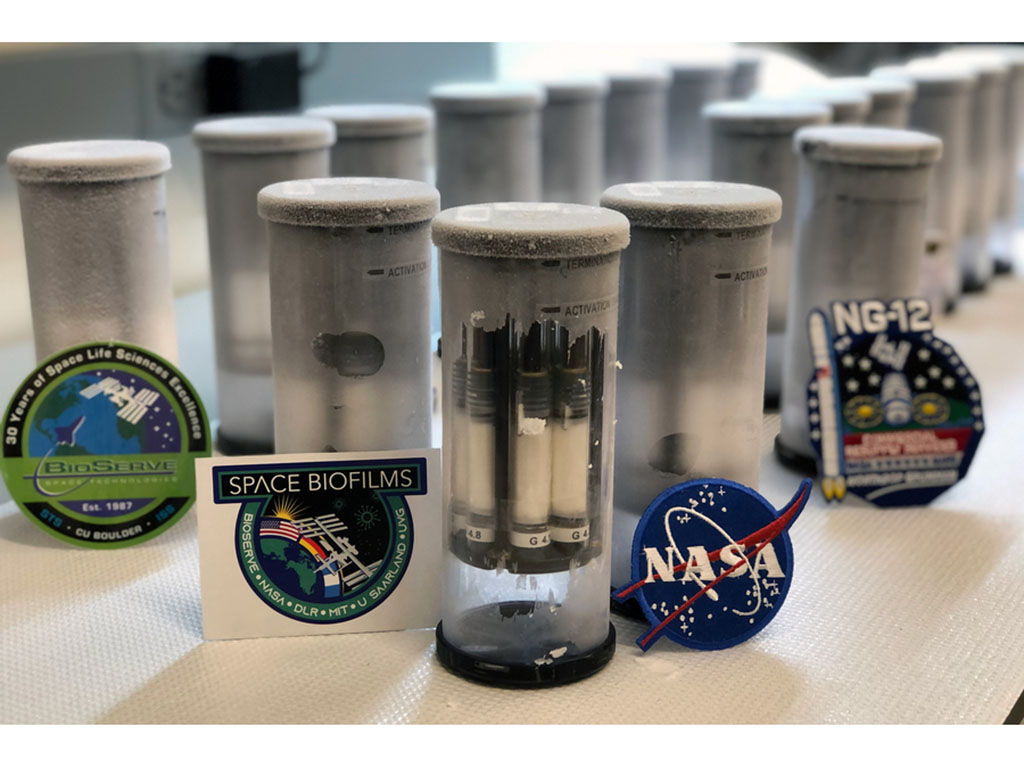How to prevent biofilms in space
After exposure in space aboard the International Space Station, a new kind of surface treatment significantly reduced the growth of biofilms, scientists report. Biofilms are mats of microbial or fungal growth that can clog hoses or filters in water processing systems, or potentially cause illness in people.
In the experiment, researchers investigated a variety of surfaces treated in different ways and exposed to a bacteria called Pseudomonas aeruginosa, which is an opportunistic pathogen than can cause infections in humans, especially in hospitals. The surfaces were incubated for three days aboard the space station, starting in 2019. The results show that textured surfaces impregnated with a lubricant were highly successful at preventing biofilm growth during their long exposure in space. The findings are described in a paper in the journal Nature Microgravity, by Samantha McBride PhD ’20 and Kripa Varanasi of MIT, Pamela Flores and Luis Zea at the University of Colorado, and Jonathan Galakza at NASA Ames Research Center.
Clogs in water recovery system hoses aboard the ISS have been so severe at times, the hoses had to be sent back to Earth for cleaning and refurbishing. And while it isn’t known whether biofilms have directly contributed to astronaut illnesses, on Earth, biofilms are associated with 65 percent of microbial infections, and 80 percent of chronic infections, the researchers say.
One approach to preventing biofilms is to use surfaces coated with certain metals or oxides that kill microbes, but this approach can fail when a layer of dead microbes builds up on the surface and allows biofilm to form above it. But this was not the case with the liquid-infused surface that performed well in the ISS experiments: Rather than killing the microbes, it prevented them from adhering to the surface in the first place.
The specific surface used was made of silicon that was etched to produce a nanoscale forest of pillars. This spiky surface is then infused with a silicon oil, which is drawn into the texture and held in place by capillary action, leaving a smooth and highly slippery surface that significantly reduces the adhesion of microbes and prevents them from forming a biofilm.
Identical experiments were conducted on Earth as well as on the space station to determine the differences produced by the microgravity environment in orbit. To the researchers' surprise, the liquid-infused surface performed even better in space than it did on Earth at preventing microbial adhesion.
Previous tests on Earth had shown that these treated surfaces could significantly reduce biofilm adhesion. When the samples from the space station were retrieved and tested, “we found that these surfaces are extremely good at preventing biofilm formation in the space station as well,” Varanasi says. This is important because past work has found that microgravity can have a significant influence on biofilm morphologies, attachment behavior, and gene expression, according to McBride. Thus, strategies that work well on Earth for biofilm mitigation may not necessarily be applicable to microgravity situations.
Preventing biofilms will be especially important for future long-duration missions, such as to the moon or Mars, where the option of quickly returning fouled equipment or sick astronauts to Earth will not be available, the team says. If further testing confirms its long-term stability and successful biofilm prevention, coatings based on the liquid-treated surface concept could be applied to a variety of critical components that are known to be susceptible to biofilm fouling, such as water treatment hoses and filters, or to parts that come in close contact with astronauts, such as gloves or food preparation surfaces.
In the terrestrial samples, biofilm formation was reduced by about 74 percent, while the space station samples showed a reduction of about 86 percent, says Flores, who did much of the testing of the ISS-exposed samples. “The results we got were surprising,” she says, because earlier tests carried out by others had shown biofilm formation was actually greater in space than on Earth. “We actually found the opposite on these samples,” she says.
While the tests used a specific and well-studied gram-negative kind of bacteria, she says, the results should apply to any kind of gram-negative bacteria, and likely to gram-positive bacteria as well. They found that the areas of the surface where no bacterial growth took place were covered by a thin layer of nucleic acids, which have a slight negative electric charge that may have helped to prevent microbes from adhering. Both gram-positive and gram-negative bacteria have a slight negative charge, which could repel them from that negatively charged surface, Flores says.
Other types of anti-fouling surfaces, Varanasi says, “work mostly on a biocidal property, which usually only works for a first layer of cells because after those cells die they can form a deposit, and microbes can grow on top of them. So, usually it’s been a very hard problem.” But with the liquid-impregnated surface, where what is exposed is mostly just the liquid itself, there are very few defects or points where the bacteria can find a footing, he says.
Although the test material was on the space station for more than a year, the actual tests were only performed over a three-day period because they required active participation by the astronauts whose schedules are always very busy. But one recommendation the team has made, based on these initial results, is that longer-duration tests should be carried out on a future mission. In these first tests, Flores says, the results after the third day looked the same as after the first and second days. “We don’t know for how long it will be able to keep up this performance, so we definitely recommend a longer time of incubation, and also, if possible, a continuous analysis, and not just end points.”
Zea, who initiated the project with NASA, says that this was the first time the agency has conducted tests that involved joint participation by two of its science programs, biology and physical sciences. “I think it stresses the importance of multidisciplinarity because we need to be able to combine these different disciplines to find solutions to real world problems.”
Biofilms are also a significant medical issue on Earth, especially on medical devices or implants including catheters, where they can lead to significant disease problems. The same kind of liquid-impregnated surfaces may have a role to play in helping to address these issues, Varanasi says.
The project was supported by NASA and used facilities provided by several other companies and organizations.


